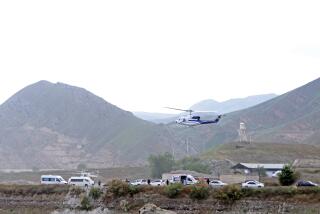New Website Forecasts Probability of Quakes
Today’s forecast: Sunny skies, highs in the 70s -- and a 1-in-10,000 chance that an earthquake will cause shaking severe enough to move heavy furniture.
The quake forecast comes from a new U.S. Geological Survey website that launched Wednesday, providing the public for the first time with an up-to-date quake-probability map for all of California: pasadena.wr.usgs.gov/step.
The map, which resembles the daily offerings from meteorologists, is based on the work of Geological Survey seismologists in Pasadena, who have developed a model to predict the likelihood of strong ground-shaking in California over a 24-hour period.
The forecasting model, described in the current issue of the science journal Nature, combines two well-known laws of seismology with long-term predictions of earthquake risk. Because dozens of quakes occur each day, the model continuously updates the probability of shaking throughout the state.
About one-third of the map is shaded blue, reflecting a one-in-a-million chance of a significant quake in the next 24 hours. The coastline ranges from turquoise to greenish teal, where odds are closer to 1-in-10,000. Parkfield, the Monterey County town hit by a 6.0 quake last fall, is the brightest yellow spot in the whole state, with its 1-in-1,000 chance of strong shaking.
Because it feeds off information from previous events, the model is best at forecasting quakes that follow other quakes. That means it is ideally suited to predicting the intensity and location of aftershocks, said Geological Survey seismologist Matt Gerstenberger, chief architect of the model.
It also means the model can’t be trusted to foretell the Big One, since large quakes are preceded by a foreshock only about half the time, he said.
“What most people want as an earthquake prediction, we still can’t do that,” Gerstenberger said.
Had it been operational in June 1992, it would have forecast a roughly 1-in-100 chance of strong shaking in the 24 hours before the high desert town of Landers was hit with a magnitude 7.3 quake, according to the study. The model would have all but guaranteed a serious temblor in Big Bear, which was hit with a magnitude 6.3 aftershock three hours later.
Duncan Agnew, a professor at UC San Diego’s Institute of Geophysics and Planetary Physics, said the model’s predictions are as reliable as weather forecasts.
“What it’s saying almost always is that ... you don’t expect to have anything happen,” Agnew said. “It’s like predicting every day that in Southern California there will be late night and early morning low clouds. It will be right most of the time.”
In designing the model, Gerstenberger started with the standard Geological Survey hazard maps, which gauge the probability of major ground shaking over periods as long as 50 years. He converted those long-term risks into probabilities for shaking during any given day.
Then he layered in other models, including one developed after the 1989 Loma Prieta earthquake by Geological Survey scientists Lucy Jones and Paul Reasenberg. Their system combined two well-established laws of seismology: the Gutenberg-Richter relationship, which describes the distribution of earthquakes according to their magnitude; and the Omori Law, which holds that aftershocks become less frequent over time.
Gerstenberger decided to bypass the traditional practice of measuring earthquakes by their magnitude and instead focused on the intensity of shaking their magnitude would produce.
He tuned his model to forecast the probability of an event that would register a 6 on the Modified Mercalli Scale of ground motion -- intense enough to be felt by all and cause slight damage to buildings.
“That’s when people start to get scared a little bit,” he said.
The model churned out daily forecasts using earthquake data from 1998 through 2002, and those forecasts were in line with actual events. It outperformed three other models in predicting quakes around Landers using data from 1992 to 2001, according to the study.
Agnew said Gerstenberger’s model is particularly good at answering the two questions that are foremost on people’s minds following a big shake: What is going to happen next? And does this boost the chances for an earthquake where I am?
He and others said it is difficult to predict how the public will react to the daily quake forecasts.
“Maybe you’ve been putting off something like getting water and food in place and charging your flashlight batteries,” said UCLA seismologist David Jackson. “You may say, ‘There’s only a 1-in-1,000 chance, so I won’t bother.’ If it’s 1-in-10, maybe you’ll say, ‘Now’s the time.’ ”
More to Read
Start your day right
Sign up for Essential California for news, features and recommendations from the L.A. Times and beyond in your inbox six days a week.
You may occasionally receive promotional content from the Los Angeles Times.







